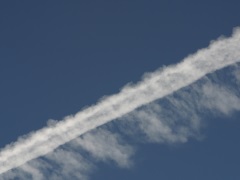Features
Sky-high biofuel research
Date: 2017-03-15 15:28:28.0
Author: Jon Evans

The effect of automobiles on the environment is entirely negative. Not only do they emit carbon dioxide that contributes to global warming, but they emit a whole host of other chemicals, including aerosol particles, that can degrade air quality and cause health problems. The effect of jet planes on the environment, however, is rather more complex and nuanced, and may not be entirely negative.
Just like automobiles, jet planes emit carbon dioxide and aerosol particles, but, aside from take-off and landing, they emit them high up in the atmosphere. So although the emitted carbon dioxide still has the same effect on global warming, the particles don’t have the same effect on air quality. Furthermore, jet planes often produce white contrails, caused by water vapour emitted by their engines condensing into water droplets and ice particles at the low temperatures found at high altitudes. This process is often enhanced by the emitted aerosol particles, which provide surfaces on which the water vapor can condense.
Not only do these contrails look like long white clouds, but they act like clouds as well, meaning they can both reflect incoming sunlight back into space, reducing global warming, and prevent heat from escaping into space, increasing global warming. Contrails can also trigger the growth of more clouds, further influencing the reflection of sunlight and trapping of heat. The precise balance between this reflection and trapping depends on a whole host of factors including the season and the time of day, and so scientists are unclear about the overall effect of contrails on global warming.
They are even less sure what happens when biofuels are added into the mix. Numerous tests conducted by various different airlines over the past few years have revealed that jet planes will fly perfectly happily on blends of conventional jet fuel and biofuels, and a few airlines have already used such blends on commercial flights. No one had investigated, however, what effect these blends might have on the exhaust fumes emitted by the jet engines, and thus on the formation of contrails, which will determine the overall effect of these blends on global warming.
This is what a team of researchers from the US, Canada and Germany, led by Bruce Anderson at NASA Langley Research Center, has now done. They flew three aircraft kitted out with various analytical instruments, including a condensation particle counter and an aerosol size spectrometer, behind a NASA research aircraft, in order to analyze the exhaust fumes produced by its four engines when cruising. Each of these engines could be fed by fuel from five separate tanks, allowing the researchers to investigate the exhaust fumes produced by various different fuels.
In this study, they compared three different fuels: two conventional jet fuels, which differed in their sulfur concentrations, and a 50:50 blend of conventional jet fuel and a bio-based jet fuel. This bio-based version was produced by treating Camelina oil with hydrogen to produce what is known as a hydrotreated esters and fatty acids (HEFA) fuel.
As reported in Nature, the researchers found that, compared with the two conventional jet fuels, the biofuel blend reduced both the number and mass of emitted particles by 50–70%, with a particular reduction in the number of larger, soot-like particles. On the face of it, this might imply that biofuel blends should reduce the formation of contrails, by providing fewer surfaces for the condensation of water droplets and ice crystals. However, Anderson and his colleagues suggest that the biofuel blend might actually produce thicker contrails, because these blends contain more hydrogen, and thus should produce more water, than conventional jet fuels.
So even though this research confirms that biofuel blends alter the composition of the exhaust from jet engines, it simply adds more complexity to the question of whether the resultant contrails exacerbate or mitigate global warming.
The views represented here are solely those of the author and do not necessarily represent those of John Wiley and Sons, Ltd. or of the SCI.
Displaying 6 keywords used to tag this article:
- omega speedmaster
- Copy Watches Bell & Ross BR01-94 [1
- Prada Totes
- Moncler Schal
- Replica Omega Watches Chronometer 3
- Mont Blanc Paso Doble Rouge Roller
